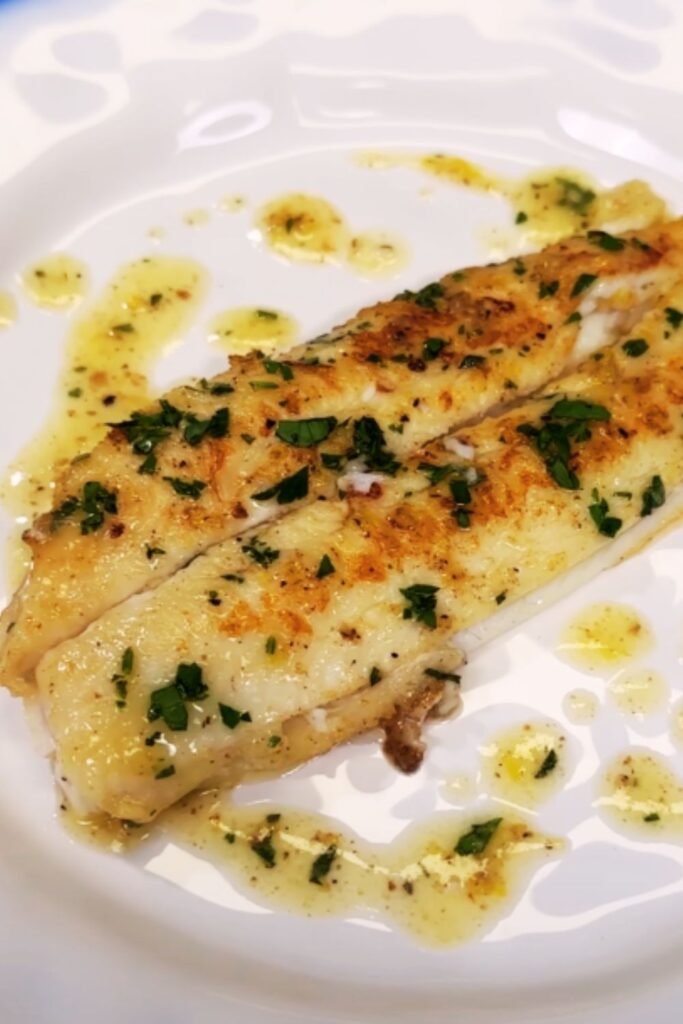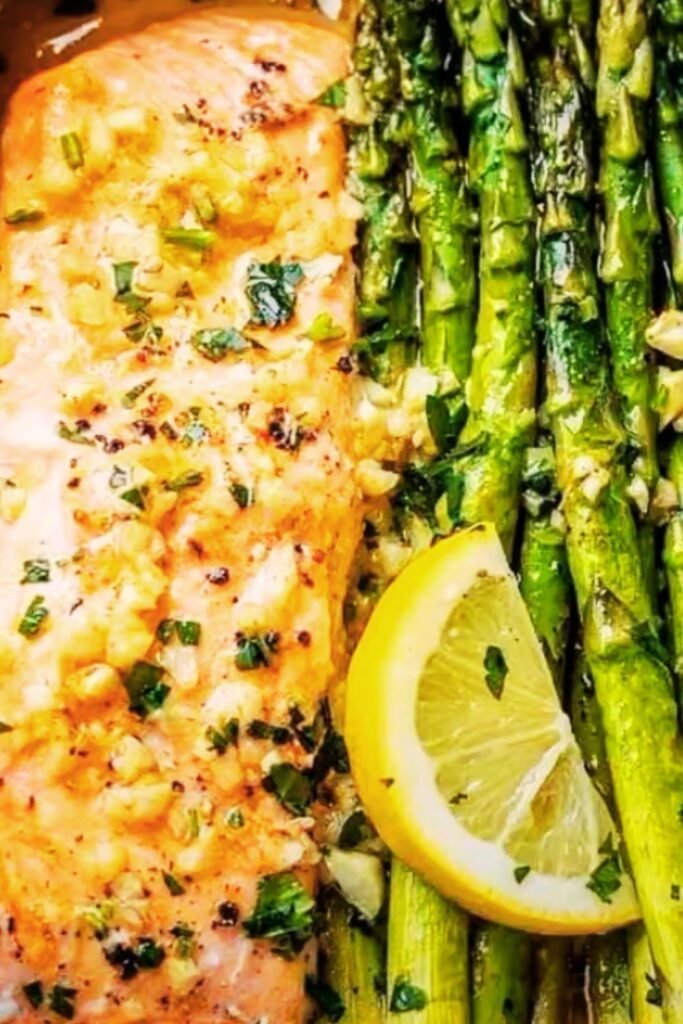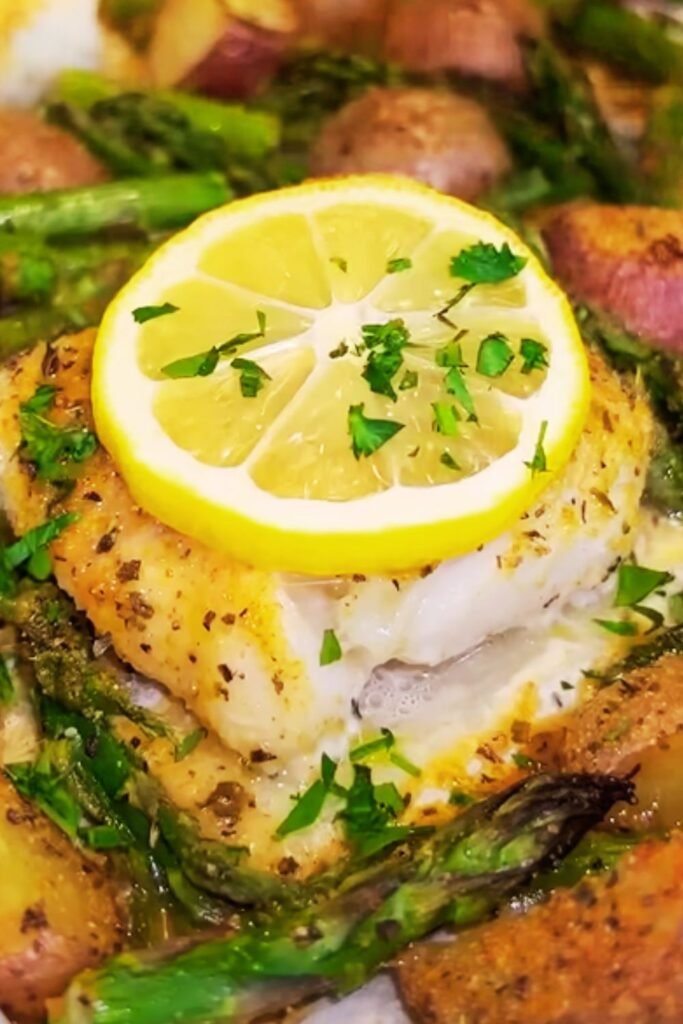There’s something magical about the combination of delicate flounder fillets bathed in a rich, aromatic lemon garlic butter sauce. I’ve been perfecting this baked flounder recipe for years, and I can confidently say it’s become one of my most requested dishes among family and friends. The beauty of this recipe lies not only in its incredible flavor but also in its simplicity – it’s elegant enough for special occasions yet easy enough for a weeknight dinner.
When I first started cooking flounder, I was intimidated by this delicate fish. However, I quickly learned that with the right technique and timing, baked flounder becomes a show-stopping centerpiece that melts in your mouth. The key is understanding how to work with flounder’s naturally tender texture while enhancing its mild, sweet flavor with complementary ingredients.
Understanding Flounder: The Perfect Canvas for Flavor
Flounder : A flatfish known for its delicate, flaky texture and mild, slightly sweet flavor profile
Lemon Garlic Butter : A classic French-inspired sauce combining butter, fresh garlic, lemon juice, and herbs
Baking Method : A gentle cooking technique that preserves the fish’s moisture while allowing flavors to meld
Flounder belongs to the flatfish family, and what makes it particularly special is its incredibly fine, flaky texture. Unlike meatier fish such as salmon or tuna, flounder has a subtle flavor that acts as a perfect canvas for bold seasonings and sauces. When I select flounder at the market, I always look for fillets that are translucent white with no fishy odor – fresh flounder should smell like the ocean, clean and briny.
The versatility of flounder amazes me every time I work with it. Whether you’re preparing a romantic dinner for two or hosting a dinner party, this fish adapts beautifully to various cooking methods and flavor profiles. However, baking remains my preferred technique because it allows the fish to cook evenly while the lemon garlic butter creates a beautiful, aromatic sauce that infuses every bite.
Essential Ingredients and Their Roles
| Ingredient | Quantity | Purpose | Substitution Options |
|---|---|---|---|
| Fresh Flounder Fillets | 4 pieces (6 oz each) | Main protein base | Sole, halibut, or cod |
| Unsalted Butter | 6 tablespoons | Rich sauce base | Ghee or olive oil |
| Fresh Garlic | 4 cloves, minced | Aromatic foundation | Garlic powder (1 tsp) |
| Fresh Lemon Juice | 3 tablespoons | Bright acidity | Lime juice or white wine |
| Lemon Zest | 2 teaspoons | Concentrated citrus oils | Orange zest |
| Fresh Parsley | 3 tablespoons, chopped | Color and freshness | Dill or chives |
| White Wine | 2 tablespoons | Depth of flavor | Chicken broth |
| Sea Salt | 1 teaspoon | Flavor enhancement | Kosher salt |
| Black Pepper | ½ teaspoon | Mild heat | White pepper |
| Paprika | 1 teaspoon | Color and subtle smokiness | Cayenne (pinch) |

Each ingredient in this recipe plays a crucial role in creating the final dish. The butter serves as both a cooking medium and a sauce base, while the garlic provides that essential aromatic foundation that makes the kitchen smell absolutely divine. I’ve experimented with different types of garlic – fresh, roasted, and even garlic scapes – and while each brings its own character, freshly minced garlic delivers the most balanced flavor.
The lemon component deserves special attention. I always use both juice and zest because they contribute different elements to the dish. The juice provides bright acidity that cuts through the richness of the butter and enhances the fish’s natural sweetness, while the zest contains essential oils that add an intense, concentrated lemon flavor that juice alone cannot provide.
Nutritional Benefits and Health Considerations
| Nutrient | Amount per Serving | % Daily Value | Health Benefits |
|---|---|---|---|
| Protein | 35g | 70% | Muscle maintenance and repair |
| Omega-3 Fatty Acids | 0.9g | – | Heart and brain health |
| Vitamin B12 | 2.1mcg | 88% | Nerve function and red blood cell formation |
| Selenium | 28mcg | 51% | Antioxidant properties |
| Phosphorus | 220mg | 22% | Bone and teeth health |
| Potassium | 280mg | 8% | Heart health and blood pressure regulation |
| Calories | 245 | 12% | Energy provision |
| Saturated Fat | 8g | 40% | Flavor enhancement (moderate consumption) |
What I love about this recipe is how it delivers exceptional flavor while providing significant nutritional benefits. Flounder is an excellent source of lean protein, containing all essential amino acids your body needs. The omega-3 fatty acids present in flounder support cardiovascular health and cognitive function, making this dish both delicious and nourishing.
The butter, while adding richness and flavor, should be enjoyed in moderation. I’ve found that the amount used in this recipe provides the perfect balance – enough to create a luxurious sauce without overwhelming the delicate fish. For those watching their saturated fat intake, you can reduce the butter by half and supplement with a tablespoon of high-quality olive oil.
Step-by-Step Preparation Method
Preparation Phase
Before I even turn on the oven, I ensure all my ingredients are properly prepared and at the right temperature. This mise en place approach, borrowed from professional kitchens, makes the actual cooking process smooth and stress-free.
First, I remove the flounder fillets from the refrigerator about 15 minutes before cooking. This allows them to come closer to room temperature, ensuring more even cooking. While the fish is tempering, I preheat my oven to 400°F (200°C) – this temperature provides the perfect balance for cooking the fish through without drying it out.

Next, I prepare my lemon garlic butter mixture. In a small saucepan over medium-low heat, I melt the butter slowly, being careful not to let it brown. Once melted, I add the minced garlic and cook it gently for about 60 seconds until fragrant but not colored. The key here is patience – rushing this step can result in bitter, burnt garlic that will overpower the delicate fish.
The Baking Process
I line a baking dish with parchment paper, which serves multiple purposes: it prevents sticking, makes cleanup easier, and helps distribute heat evenly. The dish should be large enough to accommodate all fillets without overlapping, allowing proper air circulation around each piece.
Pat each flounder fillet completely dry with paper towels – this step is crucial for achieving proper browning and preventing the fish from steaming in its own moisture. I season both sides of each fillet with salt and pepper, then arrange them in the prepared baking dish.
The lemon garlic butter mixture gets whisked with lemon juice, zest, white wine, and chopped parsley before being spooned generously over each fillet. I make sure to coat each piece evenly, allowing some of the mixture to pool around the fillets to create a flavorful cooking liquid.
Cooking Temperature and Timing Guide
| Fish Thickness | Temperature | Cooking Time | Internal Temperature |
|---|---|---|---|
| ½ inch | 400°F (200°C) | 8-10 minutes | 145°F (63°C) |
| ¾ inch | 400°F (200°C) | 12-14 minutes | 145°F (63°C) |
| 1 inch | 400°F (200°C) | 15-18 minutes | 145°F (63°C) |
| 1¼ inch | 375°F (190°C) | 20-22 minutes | 145°F (63°C) |
The baking time varies depending on the thickness of your fillets. Most flounder fillets are relatively thin, typically ranging from ½ to ¾ inch thick. I’ve learned to use both visual cues and internal temperature to determine doneness. The fish should be opaque throughout and flake easily with a fork when properly cooked.
Advanced Techniques and Professional Tips
After years of perfecting this recipe, I’ve developed several techniques that elevate the final result from good to restaurant-quality. One of my favorite methods involves creating a compound butter ahead of time. I mix softened butter with minced garlic, lemon zest, and herbs, then shape it into a log and refrigerate. When ready to cook, I slice medallions of this flavored butter and place them directly on the fish fillets.
Another technique I employ is the “tent method” for thicker fillets. If your flounder pieces are particularly thick, cover the baking dish with aluminum foil for the first half of the cooking time, then remove it to allow the top to develop a light golden color. This ensures the fish cooks through evenly without the surface becoming overcooked.
Temperature control is absolutely critical when working with delicate fish like flounder. I always use an instant-read thermometer to check for doneness, inserting it into the thickest part of the fillet. The internal temperature should reach 145°F (63°C) for food safety, but flounder is best when it just reaches this temperature and no higher.
Flavor Variations and Customization Options
| Variation | Additional Ingredients | Flavor Profile | Cooking Adjustments |
|---|---|---|---|
| Mediterranean | Olives, capers, tomatoes, oregano | Briny, herbaceous | Add 2 minutes cooking time |
| Asian-Inspired | Ginger, soy sauce, sesame oil, scallions | Umami, aromatic | Reduce salt by half |
| Cajun Style | Paprika, cayenne, thyme, bay leaves | Spicy, earthy | Same cooking time |
| Herb-Crusted | Breadcrumbs, mixed fresh herbs | Textural, aromatic | Increase temperature to 425°F |
| Wine-Poached | White wine, shallots, cream | Rich, elegant | Reduce to 375°F, add 5 minutes |
The beauty of this base recipe lies in its adaptability. I’ve created countless variations over the years, each bringing its own personality to the dish. For a Mediterranean twist, I add halved cherry tomatoes, kalamata olives, and a sprinkle of dried oregano to the baking dish. The tomatoes release their juices during cooking, creating a more complex sauce.
When I’m craving something with an Asian influence, I substitute half the butter with sesame oil and add freshly grated ginger to the garlic mixture. A splash of low-sodium soy sauce replaces some of the salt, creating an umami-rich coating that’s absolutely addictive.
Side Dish Pairings and Complete Meal Planning

Choosing the right accompaniments can transform this baked flounder into a memorable dining experience. I’ve found that the key is balancing the rich, buttery fish with lighter, complementary flavors and textures.
My go-to vegetable pairing is roasted asparagus with a light dusting of parmesan cheese. The asparagus’s slight bitterness provides a beautiful contrast to the fish’s richness, while the cheese adds another layer of umami without competing with the main dish. I roast the asparagus at the same temperature as the fish, timing it so both finish simultaneously.
For starch options, I prefer something that can absorb the delicious lemon garlic butter sauce. Wild rice pilaf has become my favorite choice – its nutty flavor and chewy texture provide interesting contrast, and the individual grains catch every drop of that precious sauce. Alternatively, buttery mashed potatoes or a simple risotto work beautifully.
A crisp salad helps cleanse the palate between bites. I prepare a simple mixed green salad with a light vinaigrette made from champagne vinegar and olive oil. The acidity cuts through the richness while the fresh greens add color and nutritional balance to the plate.
Storage, Reheating, and Food Safety
| Storage Method | Duration | Temperature | Reheating Instructions |
|---|---|---|---|
| Refrigerator | 2-3 days | 38°F (3°C) or below | 300°F oven for 8-10 minutes |
| Freezer | 1-2 months | 0°F (-18°C) or below | Thaw overnight, then reheat |
| Room Temperature | 2 hours maximum | – | Not recommended |
| Microwave Reheating | – | – | 30-second intervals, 50% power |
Proper storage is crucial for maintaining both food safety and quality. I always refrigerate leftover flounder within two hours of cooking, storing it in airtight containers to prevent odor absorption and moisture loss. When reheating, I prefer using a low oven temperature rather than the microwave, which can make the fish rubbery.
If you’re planning to freeze portions, I recommend doing so before adding the lemon garlic butter sauce, as dairy-based sauces can separate when frozen and thawed. Instead, freeze the seasoned, uncooked fillets individually wrapped, then prepare fresh sauce when ready to cook.
Troubleshooting Common Issues
Even experienced cooks encounter challenges when preparing fish, and I’ve certainly had my share of learning experiences with this recipe. One of the most common issues I see is overcooking, which results in dry, flaky fish that lacks the moist, tender texture we’re aiming for.
If your flounder turns out dry, it’s usually due to either too high a temperature or too long a cooking time. Remember that fish continues cooking even after removal from the oven due to residual heat, so I always err on the side of slight undercooking and let carryover heat finish the job.
Another frequent problem is watery sauce. This typically occurs when the fish releases too much moisture during cooking, diluting the butter mixture. To prevent this, ensure your fillets are thoroughly patted dry before seasoning, and consider salting them 15 minutes before cooking to draw out excess moisture.
Seasonal Ingredient Substitutions and Availability
The beauty of this recipe is its flexibility across seasons. During summer months, I love incorporating fresh herbs from my garden – basil, thyme, and tarragon all work beautifully with the lemon garlic base. Fresh corn kernels added to the baking dish create a sweet contrast that’s particularly appealing during peak summer.
Fall brings opportunities to incorporate heartier elements. I sometimes add thinly sliced fennel bulb to the baking dish, which becomes tender and sweet during cooking while adding a subtle anise note that complements the fish beautifully. Winter calls for more robust herbs like rosemary and sage, though I use these sparingly to avoid overwhelming the delicate flounder.
Spring offers the best selection of fresh citrus, and I take advantage by experimenting with different citrus combinations. A blend of lemon and lime juice creates interesting complexity, while blood orange juice adds a gorgeous color and slightly sweeter profile.
Professional Presentation and Plating
The visual presentation of this dish can elevate it from a simple weeknight dinner to restaurant-quality fare. I always warm my serving plates in a low oven before plating – this keeps the fish at optimal temperature longer and shows attention to detail.
For plating, I place each fillet slightly off-center on the plate, then spoon the pan juices around and over the fish. A sprinkle of fresh herbs and a lemon wedge provide color contrast and offer guests the option to add extra citrus brightness.
When serving for special occasions, I like to create height by serving the flounder over a small mound of the chosen starch, allowing the sauce to cascade down the sides. A few microgreens or edible flowers can add an elegant finishing touch.
Q&A Section
Q: How can I tell if my flounder is fresh when shopping? Fresh flounder should have clear, bright eyes if purchasing whole fish, or translucent white flesh if buying fillets. The smell should be ocean-fresh, never fishy or ammonia-like.
Q: Can I use frozen flounder fillets for this recipe? Yes, but ensure they’re completely thawed and patted thoroughly dry. Frozen fish tends to release more moisture during cooking, so you may need to adjust cooking time slightly.
Q: What’s the best way to prevent the fish from sticking to the baking dish? I always line my baking dish with parchment paper and lightly oil the paper. This creates a non-stick surface while making cleanup much easier.
Q: Can I prepare the lemon garlic butter sauce ahead of time? Absolutely! The sauce can be prepared up to 24 hours in advance and refrigerated. Gently reheat before using, and add fresh herbs just before serving.
Q: How do I know when the flounder is perfectly cooked? The fish should be opaque throughout and flake easily with a fork. An instant-read thermometer should register 145°F (63°C) in the thickest part.
Q: What should I do if my sauce separates during cooking? If the butter sauce separates, remove the fish and whisk in a tablespoon of cold butter or cream to re-emulsify the sauce.
Q: Can I double this recipe for a larger crowd? Yes, but use multiple baking dishes to avoid overcrowding, which can lead to uneven cooking. Keep the same temperature and timing for each dish.
Q: Is this recipe suitable for people following a low-carb diet? Yes, flounder is naturally carb-free, and the sauce contains minimal carbohydrates. Pair with low-carb vegetables for a complete meal.
Q: What wine pairs best with this dish? A crisp white wine like Sauvignon Blanc, Pinot Grigio, or Chardonnay complements the lemon garlic flavors beautifully without overpowering the delicate fish.
Q: Can I use this same method with other types of fish? This technique works well with other delicate white fish like sole, cod, or halibut. Adjust cooking times based on thickness and density of the fish.
This baked flounder recipe with lemon garlic butter has become a cornerstone of my cooking repertoire, and I’m confident it will become a favorite in your kitchen as well. The combination of simplicity and elegance makes it perfect for any occasion, while the techniques and variations I’ve shared allow you to make it uniquely your own. Remember, the key to success lies in using quality ingredients, proper timing, and gentle cooking methods that respect the delicate nature of this wonderful fish.